I’ve become very bad with password and PIN number recently. Those password management applications that I use are to blame for my memory failures, I think.
Anyway, I have forgot the PIN for my ATM card recently. I visit my bank branch and asked them to provide me with the new PIN. The lady there informed me that there is no way to reset the PIN and that they will have to issue a new ATM card for me. I was a bit surprised, but confirmed that they should proceed as my need for ATMs is rather often.
Less then a week later I have received my new ATM card and the new PIN. I have checked my account statement and saw that I was charged 5 CYP for the card renewal. OK, who cares. But what surprised me the most was that the new card was identical to the old one. Card number, expiry date and everything else were exactly the same. Now I wonder who designed this idiotic procedure? It is fifty gadzillion times easier to just change the four numbers of the PIN code, or even simply remind me what they were, than to reissue the plastic card, which is a totally other business with all paperwork travelling back and forward between branch (Limassol) and headquarters of the bank (Nicosia).
I am deeply puzzled…
